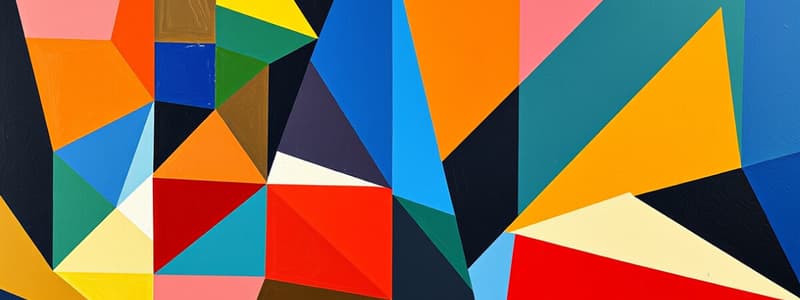Podcast
Questions and Answers
The graph represents the transformation called a _____.
The graph represents the transformation called a _____.
vertical stretch
This kind of transformation can change the _____.
This kind of transformation can change the _____.
the area of the shape and the lengths of some or all of the sides
In which quadrant will the image of vertex E' be if the square is rotated 270° clockwise about the origin O?
In which quadrant will the image of vertex E' be if the square is rotated 270° clockwise about the origin O?
Quadrant III
The center of rotation is illustrated by _____.
The center of rotation is illustrated by _____.
The angle of rotation is _____.
The angle of rotation is _____.
The line of reflection is the _____.
The line of reflection is the _____.
If the coordinate of vertex A is (-2,4), then the coordinate of vertex A' is _____.
If the coordinate of vertex A is (-2,4), then the coordinate of vertex A' is _____.
Which transformation maps hexagon 1 into 3?
Which transformation maps hexagon 1 into 3?
Triangle LMN is reflected on y = x and then translates to the left one unit. Which of the following graphs represents the sequence of transformations that maps triangle LMN onto its image?
Triangle LMN is reflected on y = x and then translates to the left one unit. Which of the following graphs represents the sequence of transformations that maps triangle LMN onto its image?
Given: Figure 1. Choose the image that corresponds to figure 1 after a reflection over the x-axis and a translation of one unit left.
Given: Figure 1. Choose the image that corresponds to figure 1 after a reflection over the x-axis and a translation of one unit left.
Match the diagram to the transformation.
Match the diagram to the transformation.
The graph represents the transformation called a _____.
The graph represents the transformation called a _____.
The graph represents the transformation called a _____.
The graph represents the transformation called a _____.
After the square undergoes an isometric transformation, its new vertices are Q'(0,0), U'(4,0), A'(4,-4), and D'(0,-4). Which of the following options best describes the type of transformation that maps QUAD onto Q'U'A'D'?
After the square undergoes an isometric transformation, its new vertices are Q'(0,0), U'(4,0), A'(4,-4), and D'(0,-4). Which of the following options best describes the type of transformation that maps QUAD onto Q'U'A'D'?
Flashcards are hidden until you start studying
Study Notes
Transformations Overview
- Vertical stretches alter the shape of figures, impacting area and side lengths.
- Transformations can change the spatial properties of geometric figures.
Rotations
- A square's vertex can be rotated 270° clockwise about the origin, moving vertex E' to Quadrant III.
- The center of rotation is identified as Point X.
- A standard rotation angle is often expressed as 90 degrees.
Reflections
- The line of reflection can be designated by the x-axis, which serves as a mirror for geometric transformations.
- Reflecting point A at coordinates (-2,4) results in point A' at (-2,-4).
Composite Transformations
- Mapping hexagon 1 to hexagon 3 involves reflections across both the y-axis and x-axis.
- For triangle LMN, a reflection over the line y = x followed by a translation leftward by one unit results in side N'L' touching the y-axis.
Image Analysis Post-Transformations
- After performing a reflection over the x-axis and translating one unit left, point N' is positioned at (-2, -1).
Diagram-Based Transformations
- Triangles can be categorized by their transformations:
- Translation is observed in blue and red triangles.
- Rotation is represented by two small purple triangles.
- Reflection can be seen with two large blue triangles.
Special Cases of Transformations
- When analyzing transformations of a square with vertices Q(0,0), U(0,4), A(4,4), and D(4,0), an isometric transformation yielding new vertices Q'(0,0), U'(4,0), A'(4,-4), and D'(0,-4) indicates the process involved a rotation.
Studying That Suits You
Use AI to generate personalized quizzes and flashcards to suit your learning preferences.




